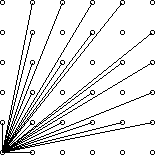Poj3090 Visible Lattice Points(欧拉函数)
欧拉函数
欧拉函数的定义:1~N中与N互质的数的个数被称为欧拉函数,我们用phi[i]来记录与i互质的数的个数。
根据算数基本定理(唯一分解定理),即N可以分解成N=p1^c1*p2^c2*…pm^cm,其中pi为质数可以推出phi[N]=N * (p1 - 1) / p1 * (p2 - 1) / p2*…(pm - 1) / pm。
欧拉函数的部分性质:phi[n] = phi[n / p] * (n % (p ^ 2) ? p - 1 : p)(其中n % p == 0)。其他性质请自行百度……
下面来看一个例题,题目链接:http://poj.org/problem?id=3090
Description
A lattice point (x, y) in the first quadrant (x and y are integers greater than or equal to 0), other than the origin, is visible from the origin if the line from (0, 0) to (x, y) does not pass through any other lattice point. For example, the point (4, 2) is not visible since the line from the origin passes through (2, 1). The figure below shows the points (x, y) with 0 ≤ x, y ≤ 5 with lines from the origin to the visible points.

Write a program which, given a value for the size, N, computes the number of visible points (x, y) with 0 ≤ x, y ≤ N.
Input
The first line of input contains a single integer C (1 ≤ C ≤ 1000) which is the number of datasets that follow.
Each dataset consists of a single line of input containing a single integer N (1 ≤ N ≤ 1000), which is the size.
Output
For each dataset, there is to be one line of output consisting of: the dataset number starting at 1, a single space, the size, a single space and the number of visible points for that size.
Sample Input
4 2 4 5 231
Sample Output
1 2 5 2 4 13 3 5 21 4 231 32549
思路:易知在每条直线上只能看到一个点,由过原点的直线的斜率公式y/x知,能看到的点的坐标为横纵坐标互质的点。从而将问题转换为求欧拉函数,通过作图(经验)知,能看到的点关于y = x 对称,因而本题要求的就是结果为3 + 2 * phi[i](i:1~n),其中的3为(1,0),(0,1),(0,0)。在进行线性筛的同时利用上面说的欧拉函数的性质将每个数的欧拉函数求出来。
代码实现如下:
1 #include <cstdio> 2 #include <cstring> 3 4 int c, n, m; 5 int v[1007], p[1007]; 6 long long phi[1007], ans; 7 8 void euler(int n) { 9 memset(v, 0, sizeof(v)); 10 m = 0; 11 for(int i = 2; i <= n; i++) { 12 if(v[i] == 0) { 13 v[i] = i; 14 p[m++] = i; 15 phi[i] = i - 1; 16 } 17 for(int j = 0; j < m; j++) { 18 if(p[j] > v[i] || p[j] > n / i) break; 19 v[i * p[j]] = p[j]; 20 phi[i * p[j]] = phi[i] * (i % p[j] ? p[j] - 1 : p[j]); 21 } 22 } 23 } 24 25 int main() { 26 scanf("%d", &c); 27 for(int icase = 1; icase <= c; icase++) { 28 scanf("%d", &n); 29 euler(n); 30 ans = 0; 31 for(int i =2; i <= n; i++) { 32 ans += phi[i]; 33 } 34 printf("%d %d %lld\n", icase, n, ans * 2 + 3); 35 } 36 }


 浙公网安备 33010602011771号
浙公网安备 33010602011771号